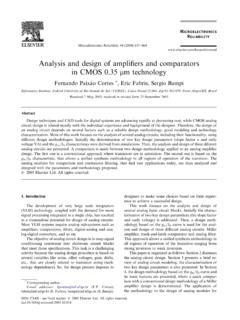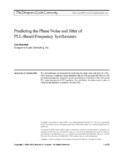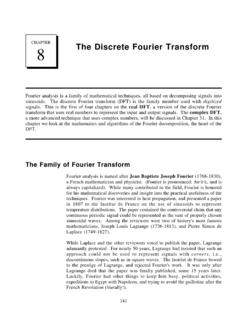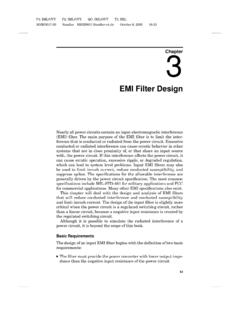Transcription of Introduction to the Fourier Series - Designer's Guide
1 The Designer s Guide Communitydownloaded from 2017, Kenneth S. Kundert All Rights Reserved1 of 28 Version 1, 31 October 2010 This paper gives an Introduction to the Fourier Series that is suitable for students with an understanding of Calculus. The emphasis is on introducing useful terminology and providing a conceptual level of understanding of Fourier analysis without getting too hung up on details of mathematical to Approach this Document. To be an electrical engineer you need to under-stand Fourier Series very well, which means that you should be able to derive every result and work every example given in this paper. I recommend that you try. Read this paper, then put it aside and try to do every derivation and example. If you can do that, then you have a good understanding of Fourier Series . In particular, I recommend that you:1. Apply (10)-(12) to (4) to prove that they are Calculate each term in the Fourier Series of (13).
2 3. Apply (69) to (68) to prove that it is Calculate Fourier Series of (73).5. Show that each of the properties given in Section 6 are updated on January 4, 2017. You can find the most recent version at Contact the author via e-mail at to make copies, either paper or electronic, of this work for personal or classroomuse is granted without fee provided that the copies are not made or distributed for profit orcommercial advantage and that the copies are complete and unmodified. To distribute other-wise, to publish, to post on servers, or to distribute to lists, requires prior written to the Fourier SeriesKen KundertDesigner s Guide Consulting, to the Fourier SeriesContents2 of 28 The Designer s Guide Introduction22. The Fourier Series33. The Fourier Orthogonal Decomposition Confirming the Fourier Coefficient Formulas114.
3 Exponential Form of the Fourier Pulse Train Example155. Power and Parseval s Theorem166. Properties of the Fourier Time Time Frequency Modulation Convolution217. If You Have Questions21 Appendix A. Time Time Frequency Modulation Convolution271 IntroductionConsider the situation where you are working with a voltage waveform that you know ispurely sinusoidal with a known frequency f, but for which you do not yet know itsamplitude and phase. Such a waveform is shown in Figure 1. A waveform of this formcan be represented with the following equation: l.(1)In this equation, only the values of A and are unknown. Once we specify those values,we have fully specified the waveform. Thus, we now have two ways to specify such awaveform: we can either give v, a function that maps time into voltage, or we can sim-vt()A2 ft +()cos=The Fourier SeriesIntroduction to the Fourier Series3 of 28 The Designer s Guide give A and.
4 Given our assumption that the waveform must be sinusoidal with fre-quency f, both specify the same waveform, but there are significant benefits to just usingA and . First, specifying two numbers is simpler than specifying an entire , the numbers can offer insight into the nature of the waveform that is difficult toget from the waveform directly. For example, in this case A is the amplitude of thewaveform and is its function v is called a time-domain representation of the waveform because it is afunction that specifies the waveform and whose domain is time (meaning that it mapstime into voltage).The alternate representation of v can be denoted (A, ). By themselves these numbersare not sufficient to represent the waveform, but when combined with (1) they providean alternate way of specifying a signal. Notice that with (A, ) we are specifying awaveform that varies with time, but that time is not included in (A, ).
5 Rather timecomes in through our waveform model, given by (1). Thus, this alternative representa-tion of the waveform consists of two pieces, a model of our waveform, in this case givenby (1), and a set of coefficients that fit into that model, in this case A and . It is oftenthe case that we must work with many waveforms that all fit the same waveform example, a linear amplifier will produce a sinusoid at its output when driven with asinusoid at its input, and they will both have the same frequency. In this case you candistinguish between the waveforms using only their coefficients with the knowledgethat they all assume the same model. For the amplifier (Ain, in) represents the wave-form at the input and (Aout, out) represents the one at the output. The gain of the ampli-fier is Fourier Series we will be generalizing this concept.
6 Use of Fourier Series allows usto provide an alternative representations for not just a purely sinusoidal waveforms, butfor any periodic waveform with a given period, but it still involves a waveform model(the Fourier Series ) and a set of coefficients (the Fourier coefficients).2 The Fourier SeriesThe basic idea of the Fourier Series is that any periodic waveform can be representedwith a sum of harmonically related sinusoids. Let s break this statement down. First, awaveform is a function of time, such as the one shown in Figure 1. A waveform is peri-FIGURE 1A voltage waveform to consider. The vertical axis represents voltage and the horizontal axis represents time. 10 10123 Introduction to the Fourier SeriesThe Fourier Series4 of 28 The Designer s Guide if it repeats itself identically after a period of time. Let the period be denoted mathematically, a T-periodic waveform v satisfies a periodic waveform with period T(2)for all t.
7 To make things simpler, let s further assume that v is a continuous function oftime. The Fourier Series of this waveform can be written as,(3)which is written more succinctly as trigonometric form of the Fourier Series (4)where b0 is assumed to be 0. This is an infinite Series , and in order for it to converge and both must go to 0 as k goes to infinity. In other words there must be somevalue of K beyond which the contributions of ak and bk become negligible for k> implies that if the sum only includes a finite number of terms it becomes anapproximation for v and the accuracy of the approximation improves as K increases.(5)for some K. This point is illustrated in Figure 2, which shows a square wave beingapproximated by a finite Fourier Series . The sum is shown for the cases in which Kequals 1, 3, 5, and 7.
8 You can see that the Series more closely approximates the functionas K increases. This process is illustrated for a sawtooth waveform on the Wikipediapage for Fourier Series ( ). I encourage you to takea look at fundamental frequency f0 is defined as the reciprocal of the period, the fundamental frequency(6)This allows us to rewrite the Fourier Series slightly as:.(7)You will notice that the sinusoids that make up the sum are all at frequencies that areinteger multiples of the fundamental frequency. These frequencies are referred to asharmonics of the fundamental frequency. Now you can see that the Fourier Series ,which is the right side of (7), is a sum of harmonically related sinusoids that represents aperiodic waveform v, which is the left side of (7).It is possible to condense (7) a bit more by rewriting it in terms of angular ()vt T+()=vt()a0a12 tT--------cosb12 tT--------sina24 tT--------cosb24 tT--------sina36 ++++++=vt()ak2 ktT-----------cosbk2 ktT-----------sin+k0= =akbkvt()ak2 ktT-----------cosbk2 ktT-----------sin+k0=K f01T---=vt()ak2 kf0tcosbk2 kf0tsin+k0= =The Fourier SeriesIntroduction to the Fourier Series5 of 28 The Designer s Guide the angular fundamental frequency(8)Then.
9 (9)The coefficients ak for k = 0 to and bk for k = 1 to (we define b0 to be 0) are referredto as the Fourier coefficients of waveform v can be represented with its Fourier coefficients, but the sequence ofFourier coefficients is not a waveform, because it is not a function of time. A more gen-eral term is needed. A signal is a physical quantity or effect, such as voltage, current, oran electromagnetic field strength, that can be varied in such a way as to convey informa-tion. Then a waveform, such as v, is often referred to as the time-domain representationof the signal because it represents the signal as a function of time. The Fourier coeffi-cients are generally referred to as the frequency-domain representation of the signal asthey vary as a function of the harmonic number k, which corresponds to a frequency, two are both representations of the same underlying signal, and so are equivalentand interchangeable.
10 Both representations are very useful and engineers become quiteadept at mentally converting from one domain to the other. The reason why is that cer-tain concepts are more easily grasped in one domain than the other, some operations areFIGURE 2A square wave being approximated by a finite Fourier Series with an increasing number of terms. 02 f0=vt()akk 0tcosbkk 0tsin+k0= = Introduction to the Fourier SeriesThe Fourier Coefficients6 of 28 The Designer s Guide easily performed in one domain than the other, and, for certain very common sig-nals, one representation is often much more compact than the The Fourier CoefficientsGiven a T-periodic signal v, it is possible to compute the Fourier coefficients of (4) withthe following equations: trigonometric form of the Fourier coefficients(10), k > 0,(11), k > 0.(12)a0 is referred to as the DC component of the signal, and ak and bk are the Fourier coeffi-cients for the kth harmonic.
















